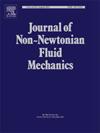用压电驱动拉伸流变法测量了不同分子量的稀聚合物溶液的拉伸特性
IF 2.7
2区 工程技术
Q2 MECHANICS
引用次数: 0
摘要
使用高速摄像机拍摄和分析了填充了稀释聚合物溶液(PEO,聚乙烯氧化物)的按需滴注(DOD)头喷射出的细丝。在较低的PEO浓度下,灯丝的衰变速度更快,在极低的浓度下几乎完全相同。拉伸弛豫时间随PEO浓度的减小呈幂律规律减小,在临界浓度cmin附近接近于一个几乎恒定的值,接近理论极限。经重叠浓度归一化的PEO浓度与经Zimm弛豫时间归一化的弛豫时间在对数图上均呈线性关系,且与分子量无关。压电驱动拉伸流变仪的幂律指数与之前的研究报告类似,例如使用液体滴注(LD)法、毛细管破裂拉伸流变仪(CaBER)和瑞利-欧内乔治喷射拉伸流变仪(ROJER)。本文章由计算机程序翻译,如有差异,请以英文原文为准。
Extensional properties of dilute polymer solutions with different molecular weights measured using piezo-driven extensional rheometry
Filaments ejected from a drop-on-demand (DOD) head filled with a dilute polymer solution (PEO, polyethylene oxide) were photographed and analyzed using a high-speed camera. The filament decay was faster at lower PEO concentrations and became nearly identical at extremely low concentrations. The extensional relaxation time decreased with as the PEO concentration decreased following the power law, and approached an almost constant value near the critical concentration , which is close to the theoretical limit. The relationship between the PEO concentration normalized by the overlapping concentration and the relaxation time normalized by the Zimm relaxation time was linear in both logarithmic graphs and independent of molecular weight. The power-law exponent in piezo-driven extensional rheometry is similar to that reported in previous studies, such as those using the liquid dripping (LD) method, capillary breakup extensional rheometry (CaBER), and Rayleigh–Ohnesorge jetting extensional rheometry (ROJER).
求助全文
通过发布文献求助,成功后即可免费获取论文全文。
去求助
来源期刊
CiteScore
5.00
自引率
19.40%
发文量
109
审稿时长
61 days
期刊介绍:
The Journal of Non-Newtonian Fluid Mechanics publishes research on flowing soft matter systems. Submissions in all areas of flowing complex fluids are welcomed, including polymer melts and solutions, suspensions, colloids, surfactant solutions, biological fluids, gels, liquid crystals and granular materials. Flow problems relevant to microfluidics, lab-on-a-chip, nanofluidics, biological flows, geophysical flows, industrial processes and other applications are of interest.
Subjects considered suitable for the journal include the following (not necessarily in order of importance):
Theoretical, computational and experimental studies of naturally or technologically relevant flow problems where the non-Newtonian nature of the fluid is important in determining the character of the flow. We seek in particular studies that lend mechanistic insight into flow behavior in complex fluids or highlight flow phenomena unique to complex fluids. Examples include
Instabilities, unsteady and turbulent or chaotic flow characteristics in non-Newtonian fluids,
Multiphase flows involving complex fluids,
Problems involving transport phenomena such as heat and mass transfer and mixing, to the extent that the non-Newtonian flow behavior is central to the transport phenomena,
Novel flow situations that suggest the need for further theoretical study,
Practical situations of flow that are in need of systematic theoretical and experimental research. Such issues and developments commonly arise, for example, in the polymer processing, petroleum, pharmaceutical, biomedical and consumer product industries.

 求助内容:
求助内容: 应助结果提醒方式:
应助结果提醒方式:


